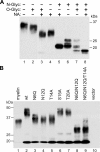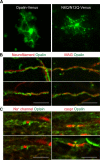Opalin, a transmembrane sialylglycoprotein located in the central nervous system myelin paranodal loop membrane
- PMID: 18490449
- PMCID: PMC3258930
- DOI: 10.1074/jbc.M801314200
Opalin, a transmembrane sialylglycoprotein located in the central nervous system myelin paranodal loop membrane
Abstract
In contrast to compact myelin, the series of paranodal loops located in the outermost lateral region of myelin is non-compact; the intracellular space is filled by a continuous channel of cytoplasm, the extracellular surfaces between neighboring loops keep a definite distance, but the loop membranes have junctional specializations. Although the proteins that form compact myelin have been well studied, the protein components of paranodal loop membranes are not fully understood. This report describes the biochemical characterization and expression of Opalin as a novel membrane protein in paranodal loops. Mouse Opalin is composed of a short N-terminal extracellular domain (amino acid residues 1-30), a transmembrane domain (residues 31-53), and a long C-terminal intracellular domain (residues 54-143). Opalin is enriched in myelin of the central nervous system, but not that of the peripheral nervous system of mice. Enzymatic deglycosylation showed that myelin Opalin contained N- and O-glycans, and that the O-glycans, at least, had negatively charged sialic acids. We identified two N-glycan sites at Asn-6 and Asn-12 and an O-glycan site at Thr-14 in the extracellular domain. Site-directed mutations at the glycan sites impaired the cell surface localization of Opalin. In addition to the somata and processes of oligodendrocytes, Opalin immunoreactivity was observed in myelinated axons in a spiral fashion, and was concentrated in the paranodal loop region. Immunogold electron microscopy demonstrated that Opalin was localized at particular sites in the paranodal loop membrane. These results suggest a role for highly sialylglycosylated Opalin in an intermembranous function of the myelin paranodal loops in the central nervous system.
Figures







Similar articles
-
Age-dependent redistribution and hypersialylation of the central myelin paranodal loop membrane protein Opalin in the mouse brain.Neurosci Lett. 2014 Oct 3;581:14-9. doi: 10.1016/j.neulet.2014.08.017. Epub 2014 Aug 19. Neurosci Lett. 2014. PMID: 25153515
-
Mammalian-Specific Central Myelin Protein Opalin Is Redundant for Normal Myelination: Structural and Behavioral Assessments.PLoS One. 2016 Nov 17;11(11):e0166732. doi: 10.1371/journal.pone.0166732. eCollection 2016. PLoS One. 2016. PMID: 27855200 Free PMC article.
-
Decreased turnover of the CNS myelin protein Opalin in a mouse model of hereditary spastic paraplegia 35.Hum Mol Genet. 2021 Jan 21;29(22):3616-3630. doi: 10.1093/hmg/ddaa246. Hum Mol Genet. 2021. PMID: 33215680
-
Myelinated nerve fibres in the CNS.Prog Neurobiol. 1993 Mar;40(3):319-84. doi: 10.1016/0301-0082(93)90015-k. Prog Neurobiol. 1993. PMID: 8441812 Review.
-
Central nervous system myelin: structure, synthesis and assembly.Trends Cell Biol. 2011 Oct;21(10):585-93. doi: 10.1016/j.tcb.2011.06.004. Epub 2011 Jul 18. Trends Cell Biol. 2011. PMID: 21763137 Review.
Cited by
-
Systematizing and cloning of genes involved in the cerebellar cortex circuit development.Neurochem Res. 2011 Jul;36(7):1241-52. doi: 10.1007/s11064-011-0398-1. Epub 2011 Jan 18. Neurochem Res. 2011. PMID: 21243430 Review.
-
Sleep and oligodendrocyte functions.Curr Sleep Med Rep. 2015 Mar 1;1(1):20-26. doi: 10.1007/s40675-014-0008-2. Curr Sleep Med Rep. 2015. PMID: 25821717 Free PMC article.
-
TRPV2: A Key Player in Myelination Disorders of the Central Nervous System.Int J Mol Sci. 2022 Mar 25;23(7):3617. doi: 10.3390/ijms23073617. Int J Mol Sci. 2022. PMID: 35408977 Free PMC article.
-
Phospholipase D family member 4, a transmembrane glycoprotein with no phospholipase D activity, expression in spleen and early postnatal microglia.PLoS One. 2010 Nov 11;5(11):e13932. doi: 10.1371/journal.pone.0013932. PLoS One. 2010. PMID: 21085684 Free PMC article.
-
OPALIN is an LGI1 receptor promoting oligodendrocyte differentiation.Proc Natl Acad Sci U S A. 2024 Aug 6;121(32):e2403652121. doi: 10.1073/pnas.2403652121. Epub 2024 Jul 31. Proc Natl Acad Sci U S A. 2024. PMID: 39083419 Free PMC article.
References
Publication types
MeSH terms
Substances
LinkOut - more resources
Full Text Sources
Molecular Biology Databases

